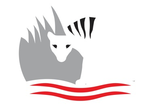|
Mindelo to Bridgetown Barbados, 2069 nm
Well I think my last post about the first attempt to cross the Atlantic frightened a few people. Sorry about that. We had already made it to Barbados safely when I posted it. The actual crossing was nowhere near as bad, but as they say, it's all relative. Perhaps I was desensitised!
It was a very rapid turn around to find our crew and ramp up our mental preparation again, probably better to get straight back on the horse though. But we made it!
In summary: We sailed 2069 nm from Mindelo, Cape Verde to Bridgetown, Barbados. During the 11.5 day crossing, from 11th to 22nd of December 2021 inclusive, ITIKI averaged 7.55kts and saw windspeeds mainly between 18-24kts true, with occasional gusts of up to 30kts. Maximum boatspeed was 14.8kts surfing one of the many waves that followed us accross. Sail configurations varied from Genoa alone, Genoa and main (broad reach and goose-winged), Parasailor® (winged-spinnaker) and goose-wing of 2 headsails. With a crew of three for the crossing we maintained a watch system consisting of 3 hours on / 6 hours off per person, until the last 24hrs, when the autopilot failed and the vessel had to be hand steered. In the last 5 hours, from 6pm, Alana and Keith maintained a 30 minutes on / 30 minutes off watch, hand-steering alternatively. The sea conditions were rough and confused and it was challenging to hold a proper course in darkness. Read on for a blow by blow description. 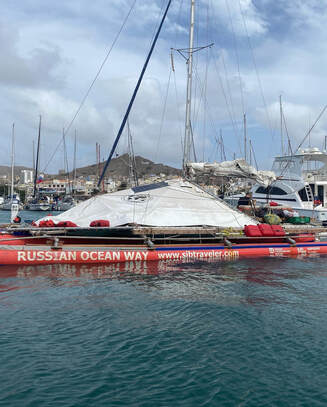 On their way to Brazil as part of a circumnavigation... On their way to Brazil as part of a circumnavigation...
Day 1 Saturday 11 Dec 2021
Well the morning has arrived. Woke with a bit of a headache after not drinking enough water yesterday and well a cosmo and wine and a late dinner. Anyway we can not stall this any longer... We checked out with the port police yesterday and put Alana on the crew list. We had our Covid test at 8:30am yesterday but can’t get the result until 6pm tonight so hopefully the plan to have it emailed to us (and Pam as a back up) works well! We called home and watched the crazy Russians leave in their “floating” tent. We pull up the anchor which is no mean feat having dug into mud in 40kts! Oh and the starboard engine MDI is officially dead. No amount of fiddling and spraying and harsh words can bring it back to life. Thank goodness for the bypass switch. Finally it’s up and we head over to the fuel dock and have to hang around for a bit waiting for another boat but finally get in and top up our tanks. We head out into the bay and put up the main and unfurl the genoa. The acceleration zone lives up to its name. We have up to 30kts behind us but its steady and manageable as is the swell. Once we passed the end of Sao Antao we got the confused seas that earlier departing sailors had reported but still good pressures in the mid 20s. Found a light patch with swirling winds which we were in for a while with TWD clocking to 320! and our speeds dropping right down to 1.5kts VMG. We have pushed north to climb just above course and are now on a beam reach with winds in the low 20s, but the beam on swell is not very nice. Alana is quite seasick and can’t stand watch so we leave her to sleep and get her sea legs. Keith and I share watches through the night and we have left over pie for dinner. 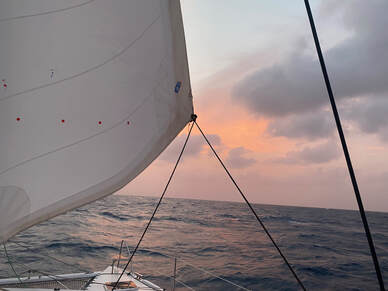 Sunset Day 2 Sunset Day 2
Day 2 Sunday 12 December
Morning comes and we are keeping the same sail configuration with 2 reefs in main and genoa initially reaching and then Goosewinging. Apparently the Dutch call this “milk maiden” after those white hats they wear. Alana is up and about and recovered her appetite. We changed to 1 reef in the main and full genoa goosewinged and breeze was holding in the high teens. We are sailing fairly conservatively. Keith has just removed this mornings’ catch of flying fish from the deck and the lazy bag. That’s going to get really smelly as there are scales all over the main! Shook out the reef in the afternoon and kept the Goosewing overnight, but it was challenging to fill the headsail when the breeze kicked around to TWD90s as it forced us up into the swell. Distance from departure at midday: 178nm 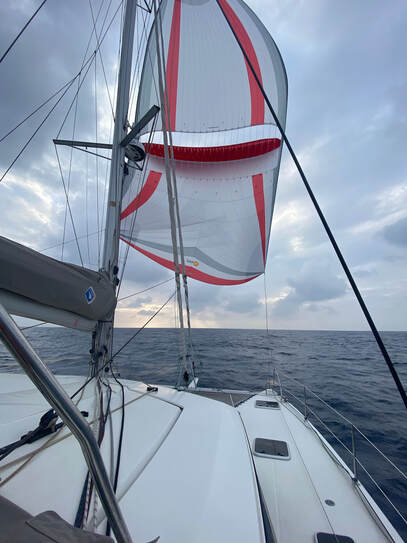
Day 3 Monday 13 December
Had a great sleep after coming off watch at 3am. Had been up briefly when the auto pilot switched off by itself and Alana called out for Keith. About 7:30am Keith and I decided to take the main and genoa down and put the kite up as we have true wind in the low 20s. Well that wasn’t easy, tried initially to furl the genoa close hauled but had to pull away to do it. Then tried to drop the main on one engine (the starboard MDI has finally failed) but that was not possible either. Finally put both on and got it down. Launched the kite after much checking and double checking and found it was inside out! That is a first. It went up and opened out beautifully but we were both left staring and wondering why the wing was not flying out the front. It did get a bit wet, but…. Then I looked at the tapes and realised the green one was on the left! It had to come down which was difficult in itself, and be rotated sheets and braces re-tied, but launched again pretty well. Thought we were in for a wine glass for sure but 20kts quickly opened it up. It’s been up all day and we are making some great VMGs but the swell is pretty big and we are moving around a lot, making daily living activities quite difficult and very noisy. Still I managed to make bread. Oh and Keith found a flying fish in the drain gutter for the anchor locker. We had a pod of dolphins come by for a while and Alana clipped on and went to the front but they did not stay long. Alana hasn’t sailed with a kite before so this is a first. Distance from departure at midday: 361nm
Day 4 Tuesday 14 December We have kept the kite up all night. A couple of times for both Alana and me the boat has rounded up and lost the kite. Initially we thought it was the autopilot but probably just a round up and the autopilot could not correct quickly enough. Keith has one episode during the day as well. Today’s catch was only 1 flying fish, lodged between the jack stay and port aft bathroom hatch. Keith launched “Flying fish crash investigation” which concluded, based on physical evidence (ie slime and scale trail) that the fish had landed on the port bow and flapped his way back along the deck until running out of steam in his final resting place, wedged on Alana’s bathroom hatch. Of course a sea burial was in order. We raised the spinnaker halyard about 5cm to avoid chafe. It’s still not all the way up (it came down a fair bit after the hoist as I took it off the winch not realising it was not cleated at the mast, so we have a fair bit of scope to keep doing this.) Keith made water and also rocked the soft shackle on the brace pulley. Otherwise not much to report as the routine of eat, sleep, watch and repeat continues. Excellent conditions continue through the day. The swell has settled into a nice rhythm, and my 3pm watch is almost hypnotic. A gentle follow sea and nothing else around. Makes me suspicious of what might be in store for us… Distance from departure at midday: 561nm 09h06 day 3 to 09h05 day 4 a 201nm run, yeeha a new 24hr distance record for ITIKI  Fresh bread underway Fresh bread underway
Day 5 Wednesday 15 December
Good progress overnight however still a few wind shifts to deal with. Through the night we have a little rain, not enough to wash the boat or clear away the grey clouds. Keith gets some unsettled winds as we parallel a rain squall. By morning the breeze is shifting through 50 degrees! TWD of 130! Seriously Hughey?! Bring back the trade winds please! I am now hand steering with the auto pilot buttons to keep the kite full. We seem to be sitting under our own personal dirty black cloud that is supplying this odd weather pattern. It is sucking our breeze away. Not only has it dropped in strength it has changed direction , shifting through 50 degrees! Not your typical trades. We finally broke away from that pattern as Alana came on watch at 9am and we have gone back on course. We have sun through the clouds and getting 5-800W from the solar. We had soup and a glass of wine for lunch and then gave the boat a wash, retrieving another flying fish in the process. The afternoon continued much the same with lighter breezes. Keith prepared a BBQ and just as it was time to serve the boat rounded up and he had to hand steer to settle the kite so dinner was not quite as smooth as planned. The boat settled but after a few more hiccups we decided to restart the instruments. It seems after a big wind shift we need to take a little more time to steady the kite before the autopilot can take over again. Distance from departure at midday: 735nm
Day 6 16 December 2021
Lighter airs continue as do relatively small seas. About 0245 I heard an unusual twang and decided to shine the torch down the side of the boat to check on it. Noticed that the soft shackle that holds the turning block for the starboard brace had broken (we rocked it yesterday) and the princess seat was acting as the turning point. Fortunately not a huge amount of pressure in it. Keith was up quickly and able to replace it with a spare so no huge drama. We think these soft shackles are the ones that Mr Messo made when he was on board a few years ago. We have a warm but partly cloudy day and shifty breeze throughout the day. We are not breaking any speed records and falling below our course again. If we want to keep the kite up we need to stay high so Keith trims on and we once again challenge ITIKI and learn how she performs. Sailing a bit shy-er to the breeze also gives us a bit better speed too. Fortunately the swell is still manageable despite the occasional slap under the bum. We are well into the rhythm of the journey and getting close to halfway. Distance from departure at midday: 900nm
Day 7 17 December 2021 As we were falling too far below course with the kite and were concerned about ending up in Trinidad and Tobago! We have changed to a 2 sail reach to climb up so we can re-hoist the kite and run away with the conditions we expect closer to Barbados. Getting the kite down was a challenge in these conditions and she fought back! We unfurled the genoa to 2nd reef to blanket the kite but this did not really help until it was down a fair way. Keith really struggled to control it and lost control of the down-haul. In hindsight a bigger ease of the sheet at the same time as the brace could have helped in the strongish wind. Also a full genoa would probably have helped as well. Coming head to wind to hoist the main was also fun with the swell and we dived down some pretty big waves, but we were able to hoist it quickly to 2nd reef point and at with this combination the rest of the day and through the night. Just as dinner was about to be served the auto-pilot had its now increasingly familiar glitch and would not steer our course. Had to hand steer for a while before she came back and cooperated again. This happened a couple of times through the night watches. Alana is very good hand steering, all of that time in dinghies has clearly paid off! I need more practice! Distance from departure at midday: 1089nm 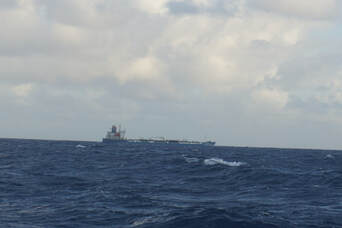 We have company We have company
Day 8 18 December 2021
Saw a cargo ship this morning, first vessel of any kind. As we have the scale set very wide on the chart plotter so I first saw it on the horizon, rather than the plotter. It came within 1nm which is ironic as we have not even seen a single boat since day 1. This morning we had some pretty rough and confused seas at it was quite uncomfortable. Also strongish winds of 22-26. After our quest to gain height was successful we are sailing the rhumb line again. This morning we evaluated whether to relaunch the kite, using the 15 minute rule, plus GST… it’s no mean feat changing configuration in these conditions. We are 3 crew and hoisting the kite means dropping the Main head to wind etc. in 3m seas. Wind has been consistently more than forecast so we decide to play it safe and keep the reefs in the main and goosewing the headsail to try and come onto course. We are still a little bit below it and of course as soon as you put in a conservative configuration the breeze backs off. It’s not really fast but it is still more comfortable with the not inconsiderable swell. It has been hard work playing the angles with the shifty breeze, which is where the kite would have been more flexible. Still a bit below course as well, so if the conditions remain consistent we may need to reconsider the kite. It was Nick’s surprise 80th birthday party today and we gave him a call during the proceedings, it was about 9pm local time. He was 3 sheets to the wind and reckons it was a complete surprise! Sounds like a great party and too bad we missed it. Distance from departure at midday: 1269nm 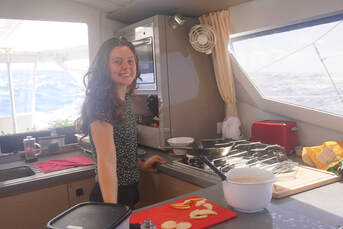 Dutch pancakes for brunch, how good is this?! Dutch pancakes for brunch, how good is this?!
Day 9 19 December 2021
We carried the goose wing through the night with a few challenges keeping it trimmed in shifty breeze and a 3 way cross sea. There were a few unintended gybes and we all had some moments of hand steering as the auto pilot can’t always keep up with the shifts and waves knocking the boat off course and then not wanting to re-engage. At times the waves lift us slowly and gently out of the water, turn us one way or the other and deposit us down into the trough. It seems like a slow gentle force but leaves you in no doubt who is in charge. We had some short, sharp and intense rain squalls through the night with moments in the 30kts. Fortunately short lived, but some work to do to recover onto course. Radar stayed on most of the night but they appear out of nowhere so quickly. At least the boat is nice and clean now! This morning we have re-launched the kite which will be much easier to manage in the shifty winds. At 10:20 we have 628nm to go, if I am not mistaken this is the start of the Sydney to Hobart. Our aim is to beat Rani’s time. First 6 hour sked , in the short handed (3 crew) short legged (2 crew are only 5’2”) division we are equivalent to just off Kiama and doing well in the cruising multihull apartment division. Kite’s up and doing 9 kts, skipper just woken up to sit down to apple crepes whipped up by the other off watch crew. I guess just like any other ‘Hobart’ race crews… Well we were getting along quite famously there for a while but the sustained strong winds combined with one too many shifty gusts and we have torn the Parasailor (kite) quite badly this evening. Thankfully she came down quickly and cleanly and is now safely stowed until we can get her repaired. For the evening and overnight we are reaching with the Genoa, still seeing gusts of 27 kts. Our VMGs are quite respectable with this configuration and it’s a comfortable ride, with standing up to 27kts gusts. We enter a period of mourning for the kite. Distance from departure at midday: 1441nm
Day 10 20 December 2021 By mid-morning the breeze has settled into the high teens, low 20s and the strong gusts have stopped, or should I say “paused”. Our genoa-only configuration is a bit limiting and our speeds are falling. The sail is strapped out as far as possible to the side so it is almost like it is poled out. In the early afternoon we try a new combination of goosewing, with the gennaker out to port and genoa to starboard. This was a bit challenging to configure as we had to gybe the genoa, then discover some problems with the gennaker sheets which meant furling to sort those out and then hoisting it behind the genoa. This configuration gives us increased flexibility of wind angle and also increased our speed by 1-2kts. Conditions are now perfect for the Parasailor of course… We keep this configuration for the rest of the day, still very confused seas and at times some larger waves coming through that throw us off course. We all have our fair share of hand steering moments, at least its good practice! Virtual Syd2Hba Sked #2: Well we are 32 hrs into our “Sydney to Hobart” race and 6nm south of Gabo Is. Checked in and all good. Still with the goosewing of genoa and gennaker. VMGs steady at 8.2kts and the wind forecast is finally delivering on predictions, well at least for wind strength if not quite direction. Wild Oats would have probably finished the race by now as leader of the demi-catamaran division, and Ricko and the boys would be having a few at Customs House, having moved out of their 3 star (pipe cot) accommodation. Meanwhile on ITIKI dinner was spaghetti bolognaise, served with freshy grated parmesan and a glass of Spanish Verdejo. The off watch crew are now retiring to their queen sized cabins after a nice hot shower in their own ensuites… Distance from departure at midday: 1613nm 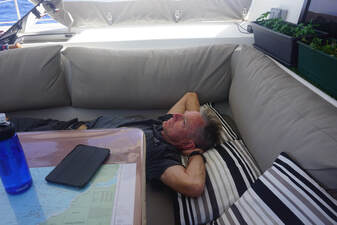 Chilling between watches Chilling between watches
Day 11 21 December 2021
With 3 crew and 3 hour watches, 3 hrs on and 6hrs off, we are rotating our actual watch times on a daily basis. Yesterday the clocks changed back 1 hour, we think to Barbados time but not sure. Keith and Alana split the extra hour so I did dinner. I have just started the 6am watch. We have carried our goosewing through the night. It was a beautiful clear night, so many stars and a full moon. Thankfully also a night without strong gusts or squalls. We have our autopilot on “Apparent wind hold” to keep the sails full despite the 15 degree wind shifts. The most challenging thing is the confused seas. A big wave can quickly push us off course and the autopilot needs some help to recover quickly. We have just ticked over to 299 nm to go and still making good speed. Distance from departure at midday: 1793nm 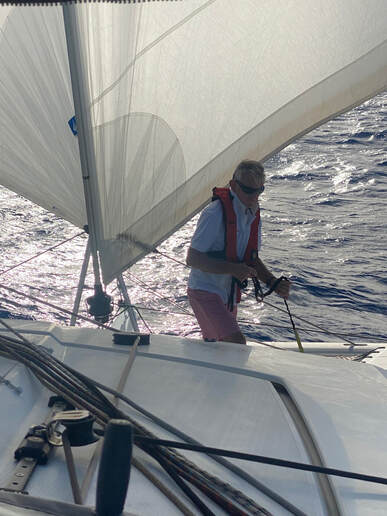 Final checks before nightfall Final checks before nightfall
Day 12 22 December 2021
Overnight the autopilot was switching off with increasing frequency and in the morning Keith hand steered for over 1.5hrs before a brief 20min reprieve when the autopilot made a comeback. This proved temporary though and it seems that with 120nm to go we are going to have to hand-steer the rest of the way. We re-evaluate the shifts to shorten them and ensure we share the load. My hand steering experience is limited and despite a rapid improvement I am not good enough to hold a course in the 23kts wind in the pitch black so Keith and Alana share the last few watches, exchanging after 30 mins. At least we can see a glow on the horizon of the lights of Barbados which helps, until the moon comes up. We keep good speeds up (8.5s), however it’s really hard work and the wind direction is in the 90s-100s so not helping us come down to the bottom of the island. With about 4nm to our waypoint we drop the sails and start motoring on two engines. Thank goodness we have detailed charts this time as the southern end of the island is fringed with reefs. We have to head around to Carlisle bay on the SW corner. Those last few miles seem to take forever. We anchor a fair way out and after a calming nightcap to unwind we collapse into bed. We will tackle the check in process tomorrow when we are fresh. Distance from departure at midnight: 2069nm
So how does it feel to be a trans-Atlantic sailor? Was it what we expected?
From the skipper: Initially a great sense of satisfaction ‘having made it’, as the adrenalin wears off exhaustion quickly fills the void as you collapse into a deep and restful sleep. I guess like most ‘firsts’ you first ocean crossing is very significant and memorable. Whilst having clocked up 10’s of thousands of nm along the coasts of NSW, Qld, Vic, Tassie and SA nothing quite compares with a crossing of one of the world’s major waterways. With coastal there is always a ‘run to’ not to far away if needed. Whilst one never stops learning when at sea, an ocean crossing opens up a whole new world of experiences. First mate: Despite numerous overnight passages, including a 5 day passage from Gibralter to Canaries, our trip down from Tenerife to Cape Verde was the best preparation possible for the eventual Atlantic Crossing. We could really experience how ITIKI performed in adverse conditions – we looked after her and she kept us safe. We had a few problems but we stayed calm when things went wrong, made good decisions and were able to solve issues underway. My own confidence has grown enormously but I remain conscious of my limitations and will never be complacent about the sea and the weather. Keith and I are a good counter-balance to each other, we complement each other’s styles and work well as a team.
4 Comments
SIDE-TRACKED ON THE WAY TO BARBADOS…
Although I have at least 5 half written blogs on the go, and a long list of excuses, I really feel the need to push this one to the top of the pile and share it. Our passage from Tenerife to Cape Verde was not an experience I would ever want to repeat but I/we learned a lot and it turned out to be a great preparation for our eventual Atlantic crossing, mentally more than anything but in practical terms too. Writing about this passage whilst it was fresh in my mind has certainly helped me to process and learn from the experience and to quickly take on board what I needed to prepare to move on and get my head into the right space. More on that later!
Day 1: Friday 26 Nov 2021
After confirming at 11pm last night that our insurance was all good to go (thanks James!) we woke early and with some nervous anticipation. The weather was better than yesterday, still cloudy but the wind was not howling and no sign of rain. It’s a cool 20C though so we have all the back clears down. We prepped to leave the marina berth, I called home and we headed across to the fuel dock to fill the tanks. Then we were off! Our first day was a baptism of fire with a bit of everything before lunch time. We motored initially and even put the fishing line out for a while. Had a huge pod of dolphins come to say farewell which was just fantastic. Then put the main up and gennaker coming into a rain squall. When the squall died so did the rain so the sails went away. The breeze seems to drop down when Keith and I are on which is frustrating. Lucky it did though because the 1st reef-line had come out of the sail and boom completely and after trying to feed a mouse-line through with the cable poker we gave up and used the 3rd reef-line to bring a new mouse line through the boom and take it and the 1st reef line back. Minutes later the breeze started building again and we needed to put the main up. Timing is everything! The starboard engine MDI did not come on. This is now officially a recurring problem. Martin suggested some electrical spray onto the connectors and that, and a bit of jiggling, got it sorted. Coming to La Gomera we came into a weather front with 26kts (gusting 30kts) on the beam and a 2-3m short swell, which was really uncomfortable. ITIKI’s hull was taking a hammering and the noise was something else! Not to mention the cumin seeds taking a tumble out of the pantry and spilling all over the floor! 2nd reef went in for the first time since the Meltemi. We had to foot off which meant making the decision to go south of Hierro Island. The breeze and swell backed off considerably as we left La Gomera behind. From there we were dead downwind and goose-winged with the genoa and have shaken out the reefs. 2 reefs go back in for the for overnight watches though in case of squalls. Soni and Martin had the 6-midnight shift and were surfing at 12+kts. Soni valiantly cooked a delicious spag bol but sadly was the only one that couldn’t eat any. The swell is brutal, there are at least three patterns, and giving the boat and our nerves a beating! Distance from departure at noon: 22nm
Day 2: Saturday 27 Nov 2021
10 mins after Keith came on watch the breeze had dropped from 14s to 6s and the frustration and flogging started. We tried chasing it for a while but we were heading too far south and finding nothing. At the start of my shift, at 3am, we re-looked at the forecast and decided we must have sailed into a wind hole, which was further north and lighter than we expected, so we gybed and slowly the pressure built until we had high teens/low 20s. We kept the apparents around 100-110 mark as we had a full genoa although 2 reefs in the main. It stayed consistent throughout my watch. Soni and Martin had some lighter breezes and shook out the reefs and changed to the gennaker. Today’s drama was when Martin noticed that small piece of the main sail track that you use to remove the cars, a section about 10cm long, had fallen off! He wasn’t sure if it hit the deck but I grabbed Keith and he found the missing piece in the lazy bag – phew! That could have been a major as dropping the main would mean losing the batten cars and bearings. Some time ago we found a mysterious grub screw inside the boat which we now know was from this part of the main track! Holy crap. Keith was able to refit the missing track and tighten everything back into place. Lucky it didn’t happen at night! Seas are still quite big (2-3m) and although the groundswell is longish (7-8 s) there is a fair bit of wind chop and cross swell on top of it so we continue to get smacked under the hull on a regular basis. Sometimes it sounds like an entire infantry battalion are running upside down under your bridge deck! It’s pretty unnerving. Weather has been fine, partly cloudy and temperatures in the low 20s. We changed our clocks to 1 hr earlier to fit with the timezone and each couple did an extra half hour on our shared watches to compensate. Winds were getting borderline for the gennaker so it has been furled around 3pm and 1 reef in the main for our night-time configuration. We are a little slower however it is much more comfortable. I slept very little yesterday, what with the swell and the creaking and adrenalin. Distance from departure at noon: 176nm
Day 3: Sunday 28 Nov 2021
Came off watch at midnight and slept really well albeit on and off until 6am when Keith went back on watch. It was another very bouncy night in terms of the swell but we covered a lot of miles. The breeze has lightened somewhat but the swell remains quite big and with a counter chop coming from another direction. We goose-winged the genoa to try to come further south as the wind was taking us north. Making good progress. The boys have done a check of the rudders, engine mounts, RIB, life-raft and the main track that came out yesterday as everything has been shaken around. Martin has done something to his knee and it looks like he could have an infection so we have started him on broad spectrum antibiotics from our medical kit. Distance from departure at noon: 372nm
Day 4: Monday 29 Nov 2021 We have come up on port tack and making our way south now, initially aiming to try and pick up some better winds or get into the trades. This also means Cap Verde remains a possible alternative port and we discuss this with Martin, whose knee is very red and hot. He consults his Dr overnight via sat. phone and the verdict is to head to Cape Verde. It should take us 3 days and we make the definitive turn to due South at 9:40am. Breeze is in the low to mid-20s with some gusts up to 30. The swell is on the beam and quite big and uncomfortable but not dangerous or slamming. We just have to ride this one out and hope Martin will be OK for the next couple of days until we can get him to a Dr. Unfortunately we don’t have the detailed charts for Cape Verde - so hopefully we will arrive in daylight. Keith went to retrieve the pennants on the mast, concerned that they might get caught in something and found the port Princess seat on the trampoline. That was screwed on pretty tightly in Leros so must have taken a big hit from a wave underneath to get it off. We had one rogue wave come over the top of the coach house and swamp the cocktail deck and helm station and gave us all a fright, particularly Soni who was on watch and got drenched. Distance from departure at noon: 545nm 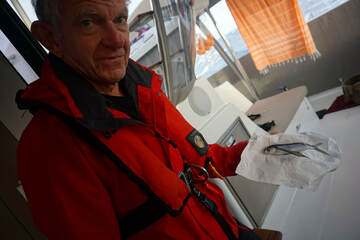
Day 5: Tuesday 30 Nov 2021
So this morning Keith was excited to find we had caught our first fish! Poor little beggar was lying on the cocktail deck in a state of rigor mortis. He was no bigger than the fish we were using as lures. He must have been tossed on board in the rogue wave that drenched Soni yesterday afternoon. Martin’s leg is looking worse if anything, not sure the antibiotics have been much use and his mobility is more limited. He will not be able to do watches tonight so the 3 of us split those. He has been advised to up the dose of antibiotics. We have been in touch with the marina and they are expecting us and will help with an ambulance if we need. We have a relatively calm afternoon so Keith decides to turn on the water-maker. This is one of the downsides of having the water maker in the foredeck hatch, he needs to clip on and go in there to do everything. We managed to fill the tanks but just as he goes back to turn everything off a wave hits us and swamps the locker and the fuse trips. I made a potato tortilla for dinner, Martin stayed in bed with his leg elevated overnight. The conditions remain pretty awful, but we have seen that ITIKI is performing well and we have kind of gotten used to the situation. A state of acceptance but certainly not enjoyment! It’s now a mission to just get there ASAP and get help for Martin. Distance from departure at noon: 734nm
Day 6: Wednesday 1 Dec 2021 Keith had sustained gusts of low 30s for the second half of his watch and Soni for the first half of hers. Breeze had settled by the time I came on watch but the swell is at its worst. Still this awful cross swell and it just slams us unexpectedly. We are getting a fair bit of water over the port side and also lots of banging on the left side of the starboard hull and under the bridge deck. The belly button (aka cockpit drain) has turned into a geyser – Keith was standing on it when a wave came up underneath and he got a spray up the leg of his shorts! ITIKI continues to perform exceedingly well and now we can see the light at the end of the tunnel, with just over 100nm to go at 9:30am. Martin made it out of bed mid-morning, feeling somewhat like the creature from the black lagoon – but also better for having rested his leg. Its not looking much better however, still very hot and swollen. He increases the antibiotic dose again. 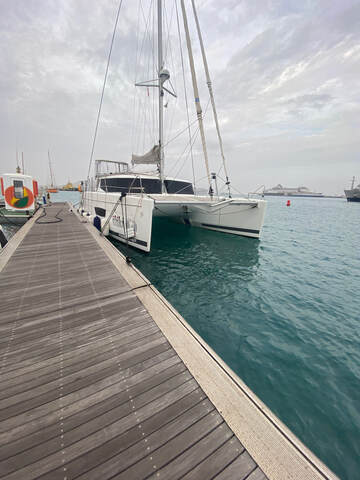 Overnight on the fuel dock Overnight on the fuel dock
Its now clear that at this pace we will be arriving at night, between midnight and 2am! It's a dark, moonless night. This is an unfamiliar and apparently wreck strewn harbour, some of the wrecks are not lit. We have no no internet to get Google Earth. Fortunately Martin had Open CPN and a GPS device on his computer. This was a godsend as he could at least provide Keith with bearings to get us past a large islet near the commercial port and into the marina area. It was a challenge to find the marina and fuel dock in the dark as it doesn’t have its own entrance or mole with navigation lights, it just sits in the corner of the harbour. The security guards were waiting for us expectantly and answered immediately on VHF, waving us into the fuel dock with their headlamps. The marina has floating docks without piles (just anchored to the seabed) and they are bouncing around incredibly in the strong winds. We manage to tie up and get settled. There was an ambulance waiting for Martin which the marina had organised. One of the young guys even gave Soni some local currency to get a taxi back to the boat. Soni and Martin returned a couple of hours later, having been given instructions to return to the hospital in the morning. Needless to say stiff drinks were in order. It was a stressful unpleasant and at times downright frightening journey - we are all very sleep deprived and running on adrenalin but we made it safely and help is at hand and that is what is important. We made the right decision to divert here, and some valuable lessons have been learned from the experience.
Distance from departure: 1016nm
So what lessons have been learned, re-learned or re-enforced.
1.Alternate destination planning For each of our longer/overnight passages I have prepared a “Float Plan” (credits to SV Starry Horizons for their template). This plan details information about our boat and safety equipment, crew list, emergency contacts and planned voyage, including alternative destinations. It’s filed with our land based “safety coordinator” in Australia, who is our primary point of contact with AMSA should we set off our EPIRB. I had listed Cape Verde as an alternative destination, never giving any further thought to what a diversion there might look like. We are crossing the Atlantic, there really are no feasible alternatives and returning against the trade winds and swell would be pretty awful. We had talked about heading to Cap Verde for a week or so and departing for the Caribbean from there, as many cruisers, including one of the ARCs does. However as we had decided against it so we had not done any detailed research and had not purchased or downloaded the detailed charts for the area. Our chart plotter only had the base map for Africa zone, which is very basic. I did know there was a marina in Mindelo on the island of Sao Vincent, and some fellow cruisers had stayed there and used it as a base. We were able to contact them and get the email address for the marina, then make contact with the marina via Satellite (Iridium Mail) to arrange our arrival. Arrival in an unknown port can be challenging enough but when you are without charts, which show navigation lights & beacons, wrecks, rocks, currents and back eddies etc. well that really adds to your woes. So lesson #1 is to better research alternative destinations. Downloading google maps or google earth for the area, even screenshots and verbal descriptions would have been really helpful. As would emergency or marina contacts. Fortunately the arrival went smoothly. 2.Meals for first night out The first night out can be tough, depending on how close to land you are the winds can be stronger in acceleration zones and seas can be lumpier close to land. Add to that any first night nerves - cooking a complex meal from scratch can be challenging and lead to sea-sickness or injury. Important to have something relatively light and easy ready to go, preferably one pot meal that can be eaten from a bowl at the helm if necessary. In fact for our “Take #2” there are several ready made meals already in the freezer! 3.Managing sea-sickness – no heroics Like I said the first night out can be challenging after being in a marina or anchorage for a few days. Rough conditions and/or first night nerves can challenge the strongest stomachs and on a dark night when the horizon is gone it is even more difficult. Hopefully not everyone is affected, Keith and I have well and truly gotten our sea legs over the last 6 months but there are no guarantees on that score. If a crew member is badly affected they will need time out of the watch system to get it under control. That may mean taking medication and/or taking some time out to sleep it off without the pressure of having to do a night watch. Day watches however are usually beneficial if they are up to it. It's not wise to try to soldier on and even cook meals. It doesn’t really do anyone any favours to prolong the adjustment time. 4.Thank goodness for Satellites We had the IridiumGO installed when we commissioned ITIKI but have never actually connected it or subscribed to a service. I bought 5 SIM cards from PredictWind (a NZ company) when we were back in Australia and activated our first subscription in Gibraltar. I chose an unlimited data package so I would not have the extra stress of counting how many minutes I have used downloading weather files etc and am so pleased I paid the extra for this. Can you imagine trying to coordinate a rescue, calling emergency services etc and then running out of credit??! Importantly, having local marina contact details and emergency contacts for the arrival port and alternative destinations would be really useful to prepare in advance. 5.ITIKI is a great boat! We have done over 10,200 nm in ITIKI since she was launched. While we obviously try to avoid going out in adverse conditions we do sometimes find things are not as forecast and we face some challenges. Strong winds, big seas etc. The trip down from the Canaries was by far the most challenging conditions mainly because they were sustained for so long. Having seen how the boat performed really did re-enforce for us how well built and solid she is. She sails well even in reefed down conditions. Whilst the waves and swell might knock her around she rarely rounded up, coping very well with constant adjustments by the hardworking autopilot. Our confidence in her has just continued to grow and we feel well attuned to her performance.
How do we move on from this?
We were pleased to be able to get Martin safely to Mindelo and into the expert care of the Medico Centro and Dr Carlos. We had of course hoped that a few days on IV antibiotics would have seen him ready to resume the journey, but sadly it was not to be. The recovery would be a lot longer and we all agreed that the risk, not only to Martin but to all of us, was too great to continue. This was indeed a heavy blow, albeit not entirely unexpected. The reality of our situation starts to sink in. So here we are in Cape Verde, a small island archipelago off the coast of Africa. The last staging post for an Atlantic crossing. We have lost our very experienced and highly regarded crew and dear friends. We were sleep deprived, stressed, shell-shocked after the horrendous journey down from the Canaries and left very much wondering WTF do we do now?! Keith has injured his shoulder in the fall off the boat onto the dock, and will eventually need surgery. Personally, I was feeling a lot of self-doubt and anguish. The ARC had reported to several yachts abandoned, including one death. We were not the only boat who diverted to Cape Verde unexpectedly either, with one of our dock mates reporting having been contacted by a cargo ship and being advised to divert due to adverse weather conditions. Various other boats reporting damage, gear failure, crew sickness or just having a shit time. What on earth made me think I could do this?! So we try to turn our minds to Plan B and for me it’s a steep climb out of a big hole to get to where I need to be mentally to restart our journey. Our options are fairly limited, but still there are always options. It’s a couple of weeks before Christmas, preparations for the Sydney to Hobart would be in full swing and everyone already has plans in place so getting sailing friends or indeed anyone experienced from Australia to join us for an impromptu Atlantic crossing would be highly unlikely, although we did explore this anyway. We also explored the idea of professional crew based in Europe, however at this time of year they are in high demand and obviously expensive. It would be a long wait for either option. While we had been approached on the docks in Canary islands by numerous people with varying skills and experience, looking for crew/passenger positions to cross the Atlantic, we were now in Cape Verde and there were a lot less people looking. At that time I remember thinking to myself, who in their right mind would take a stranger off a dock, onto their boat and across the Atlantic, to another country… Another complicating factor - as lovely, competent and caring as the Marina staff were, as well run as it is - the Marina itself was untenable in the conditions we experienced. We had gusts up to 30kts coming down into the harbour and the floating docks just bounced and swung more than anywhere I have ever seen. Steel springs, snubbers and mooring lines have been broken and cleats ripped out here. Keith had already injured his shoulder because of this. Also the stress on the boat of the constant snatching and jerking 24 hours a day made it hard to sleep or even relax. This is not a place you could leave a boat for any length of time. However this issue is one that is within our control and we decided to go and anchor out in the bay. Finally we can get a good night’s sleep, think clearly and hopefully get some plans together. I check the various crew finder sites and FB groups and the marina notice board and send out a few messages. We make contact with Alana, a young Dutch girl who came down from the Canaries in the same shitty conditions we did. Her boat decided not to continue on the crossing at this time so she moved into a hostel and waited. We met up and talked and after some initial hesitancy we decided she would be a good fit for us. Keith and I talked a lot about our experience, how the boat had performed and how we had handled our journey so far. We realised (well mainly it was me who needed convincing) that we could actually do the crossing with just the two of us. It would be tough, it would be long, it would be tiring but we could do it. Many couples do long crossings two up, but an extra pair of hands would mean sharing chores, extra rest and extra sleep, which would be a bonus. The weather was settling and the window opening up. Several boats were planning a Saturday departure and this was looking good for us too. And so the three of us, Keith, Alana and Lynda, would set off for Barbados... 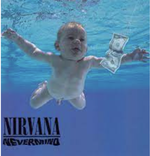 Lithium is a chemical element with the symbol Li and atomic number 3. It is a soft, silvery-white alkali metal. Under standard conditions, it is the least dense metal and the least dense solid element. Lithium’s efficacy at both treating and preventing the recurrence of manic-depressive episodes (what we now call Bipolar disorder) was discovered serendipitously by an Australian Dr John Cade back in 1949. It would eventually transform the lives of patients, pharmaceutical researchers and practicing physicians worldwide. It is still a mainstay of Bipolar disorder treatment today. The song Lithium was released as the third single from the album Nevermind by Nirvana in 1992. The title - which doesn't appear in the actual lyric – probably refers to the aforementioned drug. 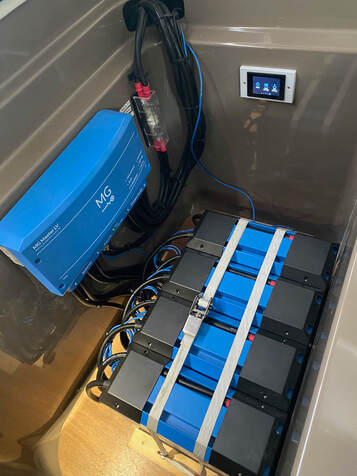 Our 4 Lithium batteries, under my bed... Our 4 Lithium batteries, under my bed... But I digress… Lithium ion batteries have become increasingly familiar to us as a key component of single use and rechargeable batteries, from the tiny button ones in watches to the ones in our phones and cameras or industrial ones that are now becoming more commonplace in cars and homes. Life on ITIKI will forever be divided into before and after Lithium batteries. I have been referring to this momentous change as an “upgrade” from AGMs to Lithium, however “conversion” is probably a more apt description as it has been akin to a religious experience, an awakening or enlightenment. Lithium upgrades are extensively discussed on cruisers fora by (sometimes self-appointed) experts and wannabes (like me) in reverent and serious tones. I feel like I have joined an exclusive club and will shortly be taught the secret handshake. Don’t get me wrong, there is nothing wrong with AGM batteries and I would have been quite happy to continue with ours had they been in better health post Covid hiatus. However one service battery didn’t make it out of the boatyard at Leros (GR) and another was pronounced dead on arrival in Gibraltar. Rather than replace them with a new set of AGMs (apparently you don’t replace 1 or 2 in a set) we decided to bite the bullet and bring forward an exercise that we had on the “eventually” to do list. 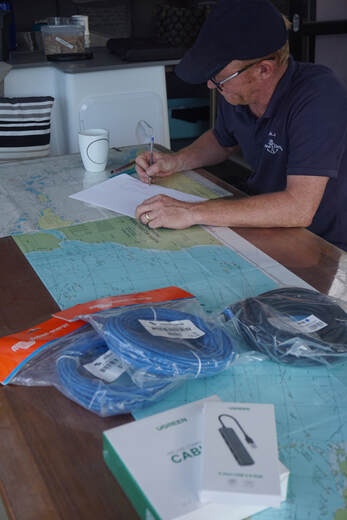 Working on the design over a cuppa Working on the design over a cuppa My knowledge of electrical systems has increased exponentially since stepping aboard ITIKI (there is so much more to cruising and living aboard than sailing skills). I have to admit to barely scraping through first year physics at uni, I have vague recollections of building a radio by copying the geek next to me. I didn’t know an amp from an ohm and my familiarity with high voltage, mainly came from Bon Scott and bandmates! My learning curve has been exponential. We encountered our first electrical “challenge” off the coast of Portugal on our way to the Med. Quelle horreur! The Bosch washing machine would not work on the genset. Calls were made to our dealer, google was consulted, but to no avail. It was the Bosch technician who visited the boat in Porto to reset the now “frozen” machine who, in halting English, dropped the penny on the problem. We got him to test the machine and power socket with the Genset on. He said something about no power and wrong frequency. More googling and I finally realised why the 5kVa and 4.5kVA genset have the same model number and user manual. It’s the same bloody machine, just set to a different RPM/frequency! D’oh! Who knew electricity had a frequency as well as a voltage and an amperage?! I really should have paid more attention in class. A fairly minor thing to get changed in the end, but really something that should have been picked up and sorted in La Rochelle. Our next valuable lesson was installing the solar panels in Sicily. A fellow sailor who was admiring our panels as they sat on the dock waiting to be fitted to their frame, happened to ask what rating our MPPT (solar controller) was. When we knowingly informed him that it was 150/75 he replied “I guess you will be wiring those panels in parallel then so you don’t blow it up!” Yes of course…. I really need to learn more about this stuff. I started reading, joined a couple of chat forums and started talking to people who knew a bit more about it than me. There are no-end of "experts" in this area and chat forums can be really daunting, so it is important to be choosy about who you listen to. Initially it was all way over my head but it has slowly come together to the point that (with some help – thanks Peter and Martin) I could brief a marine electrician about what we wanted and not be completely bamboozled when his design options came back. Getting Lithium batteries installed is not just a case of swapping out the old AGMs and replacing them with the same amount of Lithium batteries. Lithium batteries need a whole different set of charge management and monitoring systems so that they don’t overcharge, cook or blow up your engine alternators. Of course there are numerous ways to skin a cat (pardon the pun) when designing your new system. You can learn from what others have done but you can’t just copy someone else’s set up and hope for the best, even if they have a similar boat. Importantly, you can’t design a new system without (a) understanding your existing systems (b) understanding your own needs (c) clearly articulating what problems or issues you want to address (d) consulting your accountant! In my time away from ITIKI during Covid, and as part of my efforts to improve my understanding, I had put together a schematic of our energy generation, storage, monitoring and distribution, just as I had done for our water management system. I wasn’t on the boat at the time so didn’t get it 100% correct but this eventually proved a useful tool in explaining ITIKI’s set up to our marine electrician. I had made contact with Dave Campbell from EMS in Gibraltar before we returned to ITIKI as I really wanted to upgrade our inverter to a 3000W so we could run the water maker from it. A fairly conservative ambition as it turned out. At that stage I didn’t know we would be replacing our batteries, but we knew we would be passing through Gib on our way out of the Med and Dave is a Victron agent. It wasn’t long before this small job had morphed into a big one and turns out Dave and his team had the expertise to design and implement all of the changes we didn’t know we needed. Dave had worked on a number of Fountaine Pajots so was quite familiar with the layouts and wiring and all things electrical on these boats. Of course, every boat has something a little different and there will always be curve balls with these kind of jobs, but Dave was up for the challenge. It was important to us to have an experienced and accredited electrician, as well avoiding language or cultural barriers which might hamper open and clear communications. Plus Dave seemed like a really nice guy and someone we could easily work with. A longer stay in Gibraltar was now on the cards. 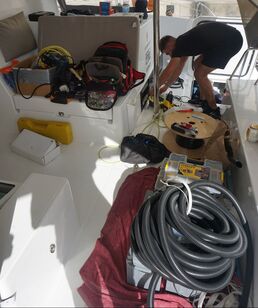 ITIKI became a workshop with cables and tools everywhere! ITIKI became a workshop with cables and tools everywhere! Defining our needs A really key step in this whole process was for us to define our needs. This meant analysing our cruising style and energy usage over the last 2 seasons as well as thinking about the cruising grounds we would be moving into, namely the Caribbean and Pacific. These are warmer climates where we would be using marinas even less and would not have access to the level of technical support available in Europe. Some people do a meticulous energy audit, calculating power usage right down to the very last detail such as the anchor light & courtesy lights. We focussed our analysis on the major appliances such as autopilot, water maker, washing machine, air con etc. How often do we run them, what are their energy ratings and how would we like to power them going forward. From that exercise we defined our key objectives.
I really could not have done this exercise before stepping onto ITIKI pre-launch. I didn’t have enough knowledge about our needs or how they could be addressed and would have made way more mistakes than we already did with our original set up. Having those 2 seasons under our belt was quite beneficial in gaining a better understanding of our requirements and how to manage energy on our boat. Our "Needs Analysis":
So how did we address all of our needs? Well I am still no expert in this area and never likely to be but here goes:
Sounds simple, right? Well yes and no. I guess it depends on how deeply you want to delve into the technical details. Dave was particularly good at explaining to mere mortals like us how things worked as well as the pros and cons of varying options available. Did it all go smoothly and exactly to plan? No of course not, nothing ever does and it is important to expect this. It’s how your installation team handle and communicate this that really matters. Dave made it clear that he was planning an upgrade on a boat he had never physically seen and his advice may change once he did see it and start working on it. Issue #1: Alternator regulators - We encountered some difficulties implementing the original design regarding the alternator/regulator set up, went some way down a rabbit hole before pulling the pin and going to plan B. The construction of the alternator made conversion to external regulation, per the original plan, very difficult. It was not possible to guarantee full control of field current and safety of engine loom wiring if we had proceeded. It would not end up being the “plug and play” scenario we thought it would be. Instead we used 2 x 30A Orion smart DC-DC chargers per engine to optimise and manage the flow of energy between engines and Lithium house batteries, via the starter batteries. Issue #2: Inverter not inverting! At the end of what should have been our last day of the install, we found that the inverter was not inverting. Yes, they tried turning it off and on again, tested and retested but still there was head scratching at the close of play. Was it a hardware problem, a wiring problem or a software problem. Finding another 3000W Inverter in Gibraltar would be challenging, and fitting 2 x 2000W would be time consuming due to space constraints. Sometimes sleeping on it is the best way to solve a problem, those 3am cogitations can be very useful if you remember them when you wake in the morning. The boys returned in the morning with a solution in hand! Turns out it was a software problem, with one too many “smart assistants” in the mix. Dylan to the rescue with some re-programming and voila! We were inverting again. Phew! What about the cost? It is true it is a significant investment and the biggest single one we will probably ever make in ITIKI. That is another reason to plan and research thoroughly and do the job properly. The time required should not be underestimated either. We were doing this on the run rather than in our winter berth, knowing that our electrician could not guarantee an exact start date given the other jobs he was working on, potential delays and set-backs as well as relying on equipment delivery etc. We would need to be in a marina for the duration of the job so we would have power to keep the beer cold. We would also be provisioning for our trip to the Canaries and beyond. The verdict so far
Everything works and we are getting used to running things a little differently. At the same time we had come into autumn/winter when there were more cloudy and rainy days and the angles of the sun was much lower, so we were not getting the same levels of solar power we were used to in mid-summer Med. We had 4 people on board for a significant stretch (instead of 2) for some long passages and we have been doing some longer times under sail, so less incidental power from motoring and more usage from the autopilot whilst sailing. We initially found that we were running the genset a little more than we normally would have to top up the batteries and heat water. Now that we are in the tropics we have found that things have changed quite a bit. Even when we have been at anchor we have been getting more sun on the panels, with daily input between 3.7KWh and 4.3KWh. Add to that the power from incidental motoring, from moving even short distances, means the use of the genset has become more rare. We are now concerned about ensuring it does have the opportunity to turn over and recharge its own starter battery. All in all we are very happy with the changes we made, we can now use our power more efficiently to run our boat the way we want to. |
AuthorAfter more than 5 years of (minus time off for Covid) and more than 27,000nm Lynda has finally got the hang of this cruising life Archives
June 2024
Categories |
||||||
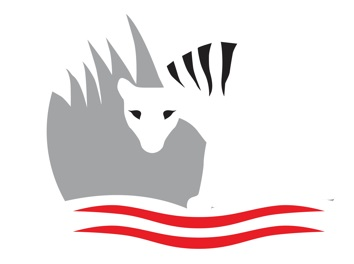
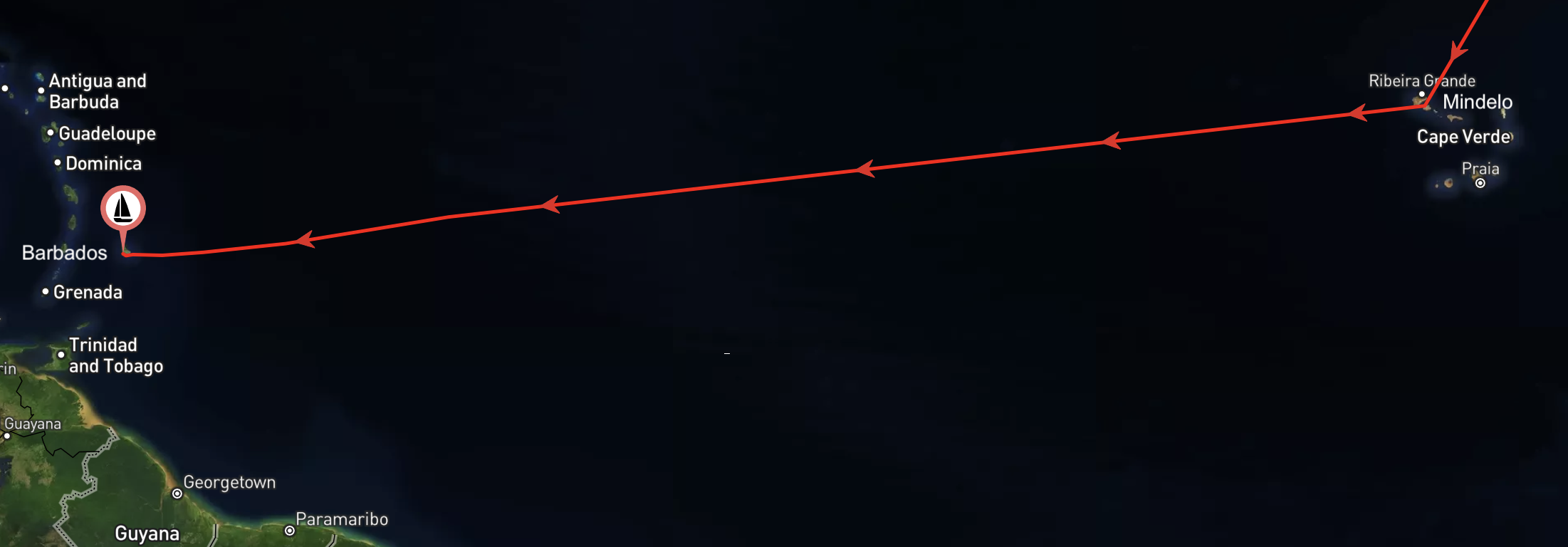
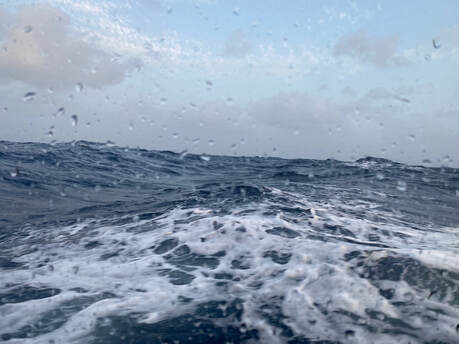
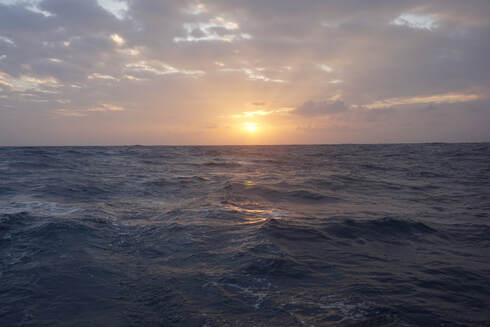
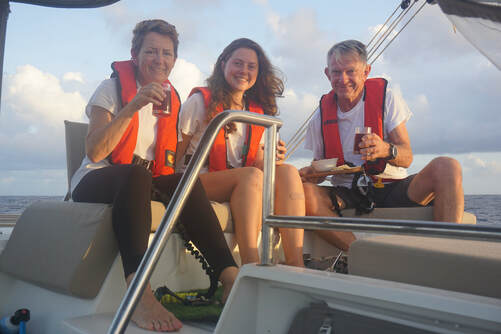
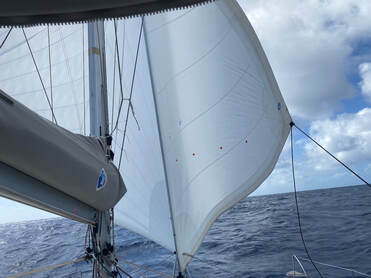

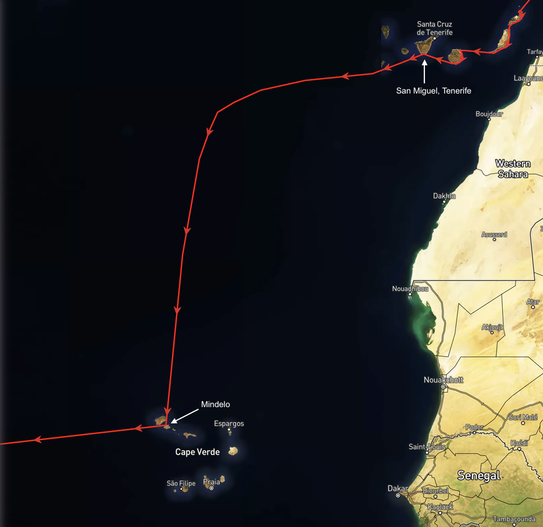
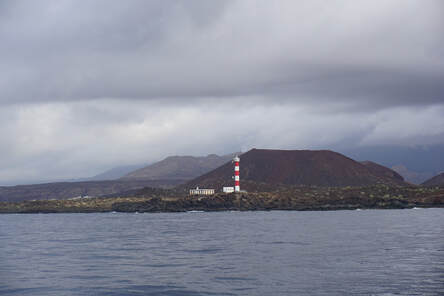
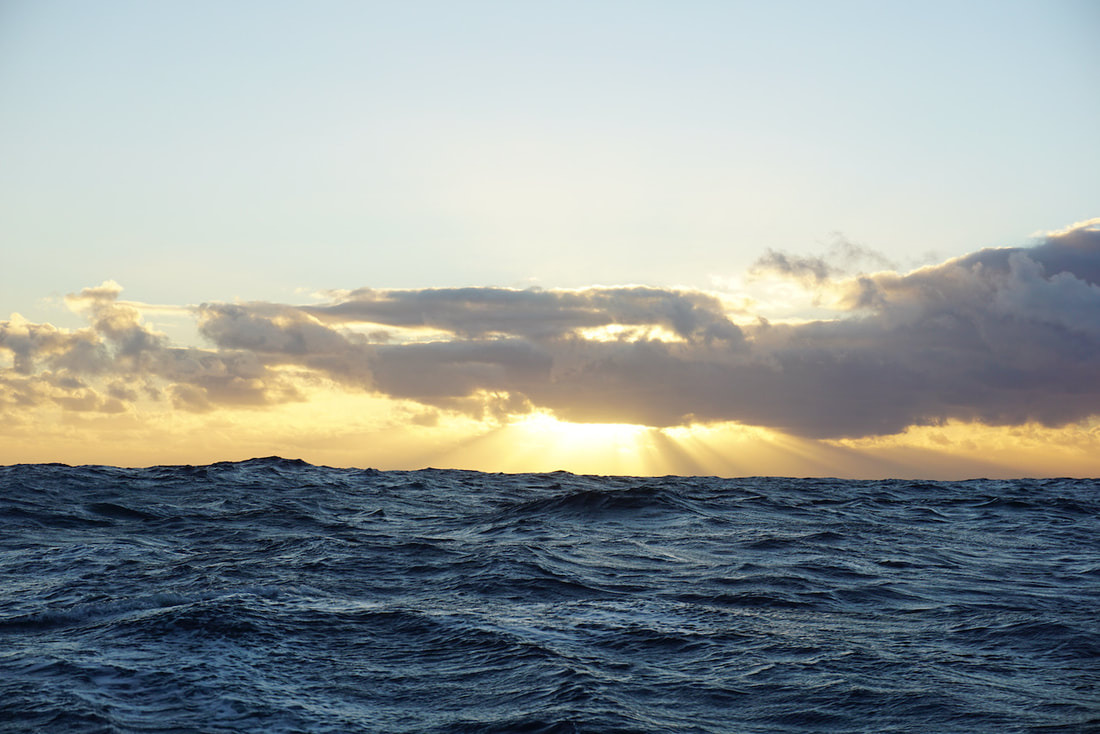
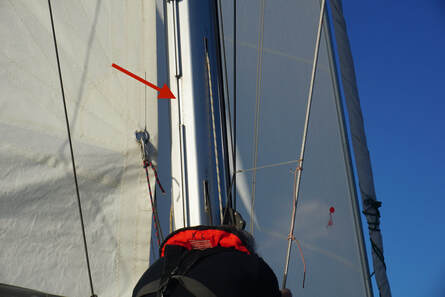
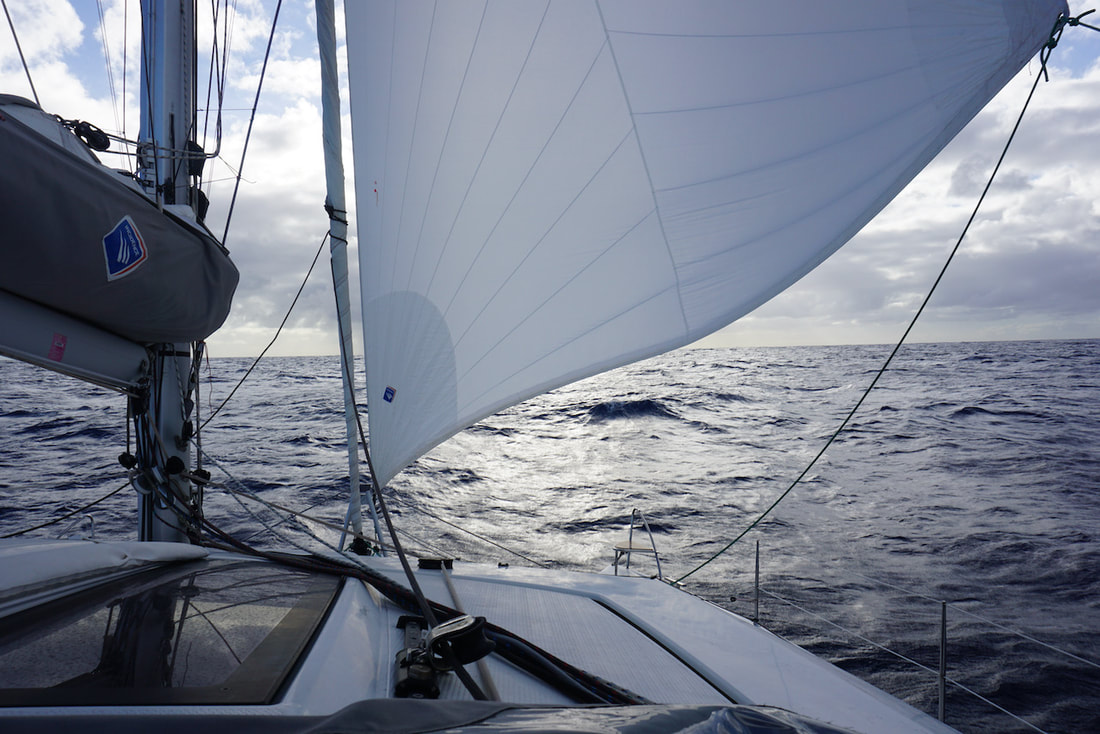
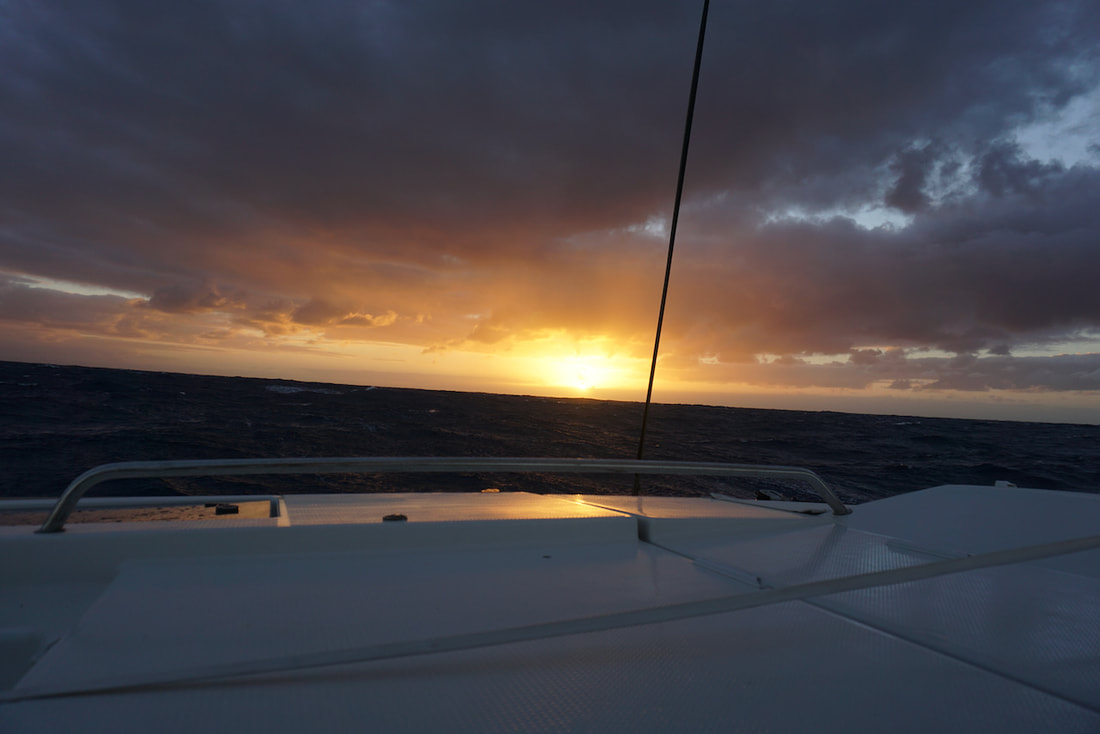
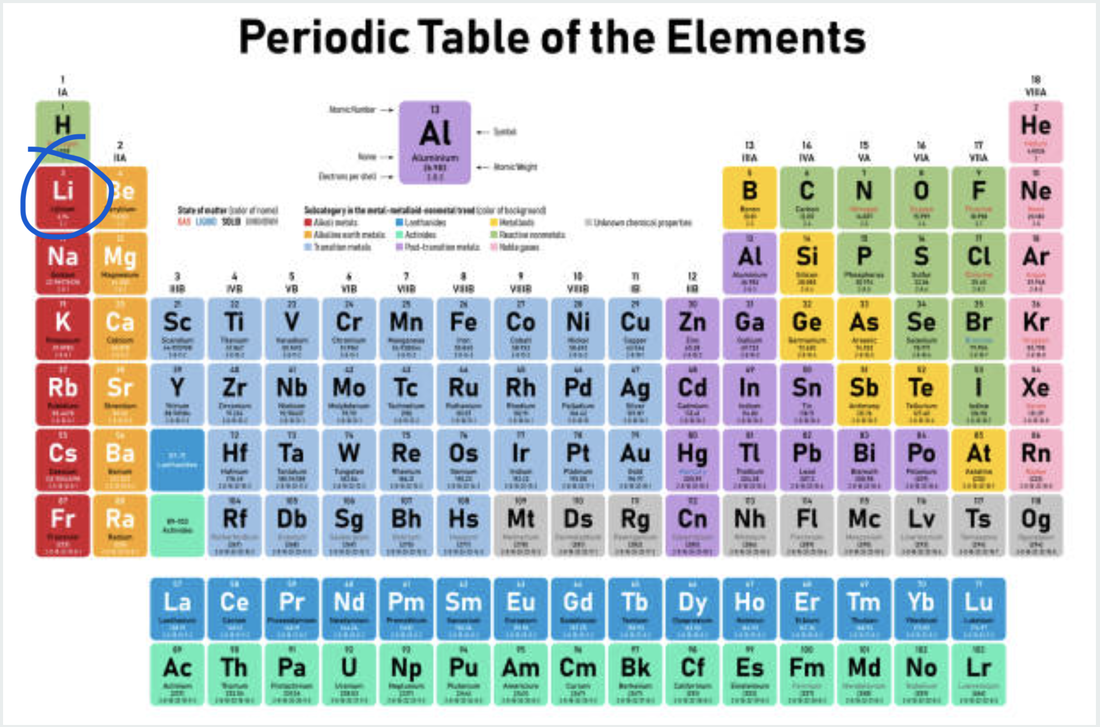
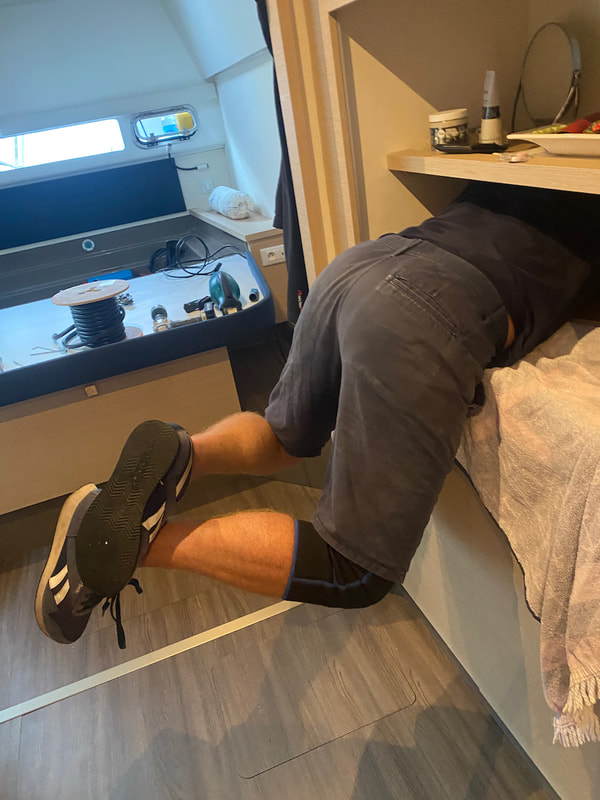
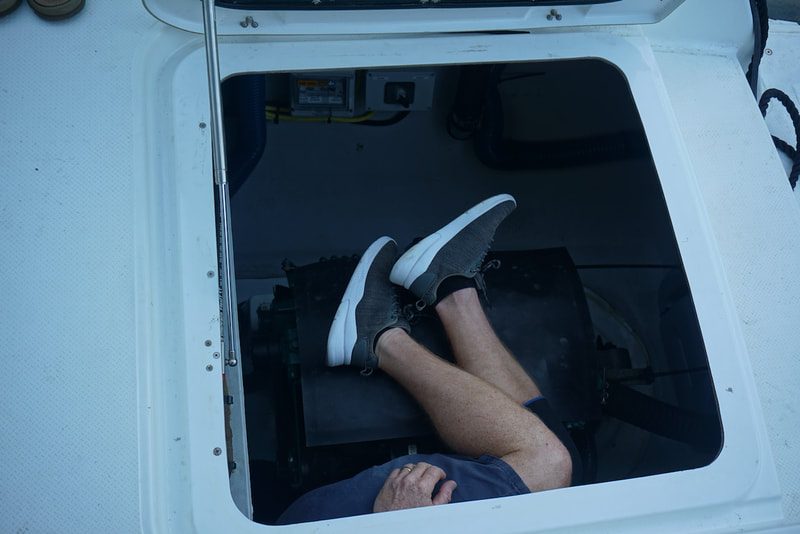
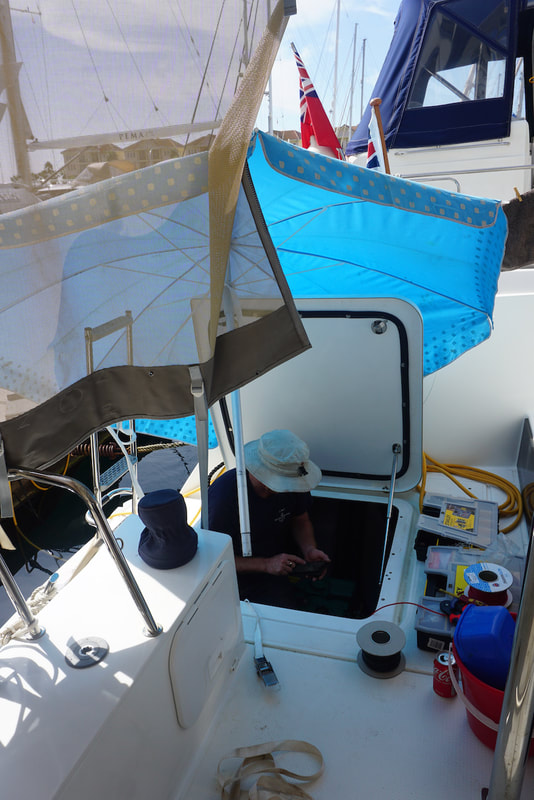
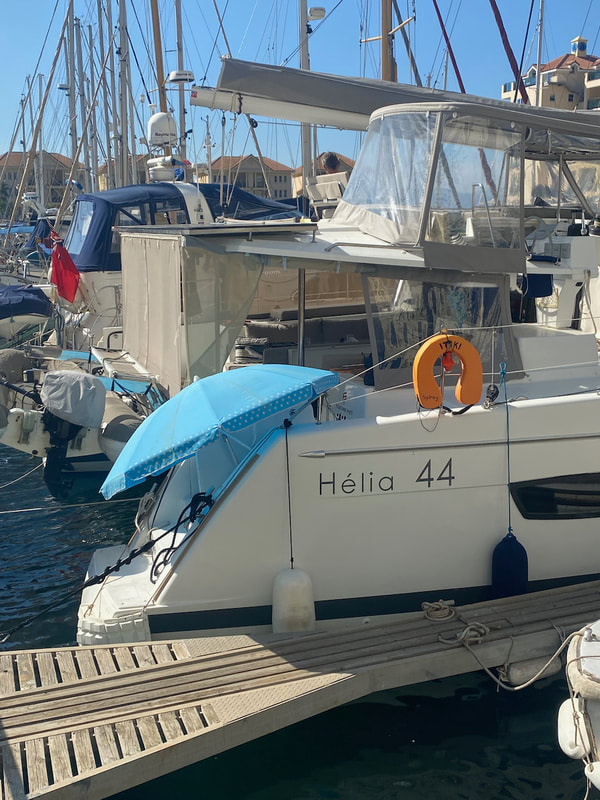
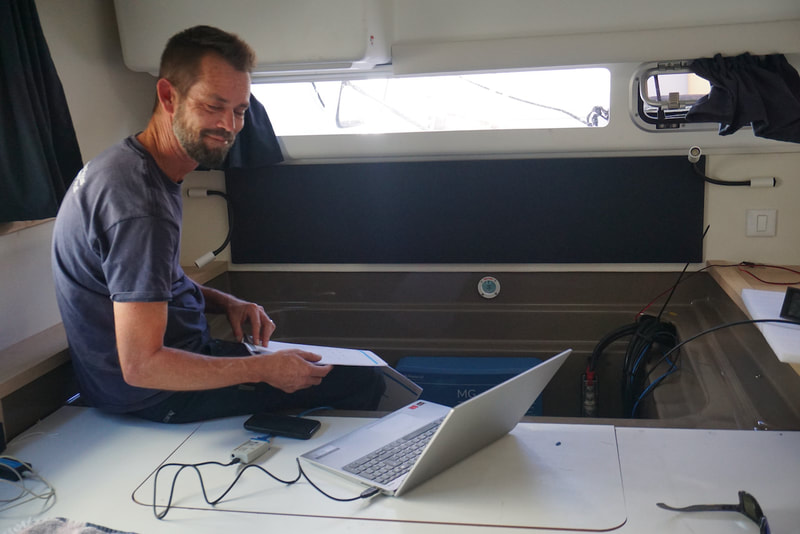
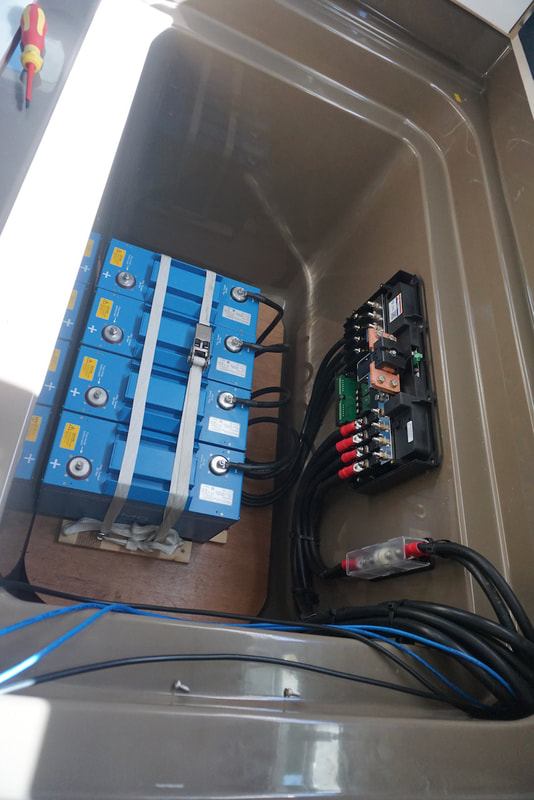
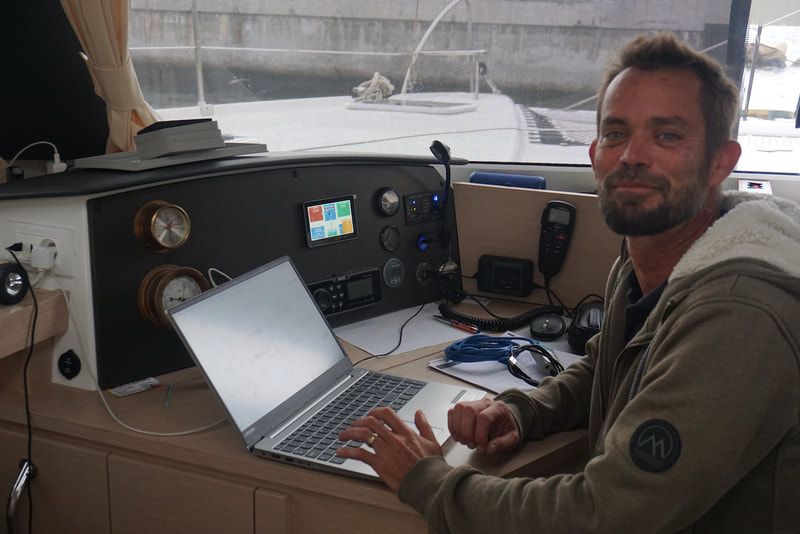
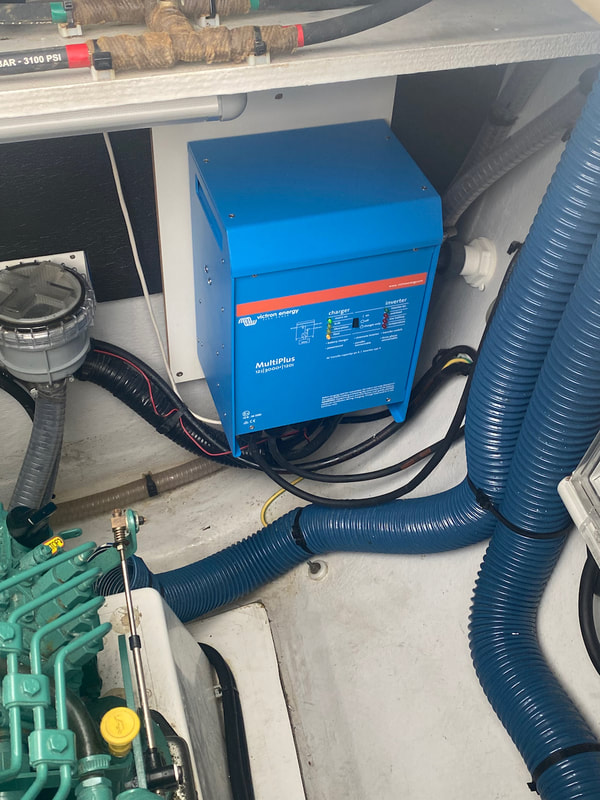
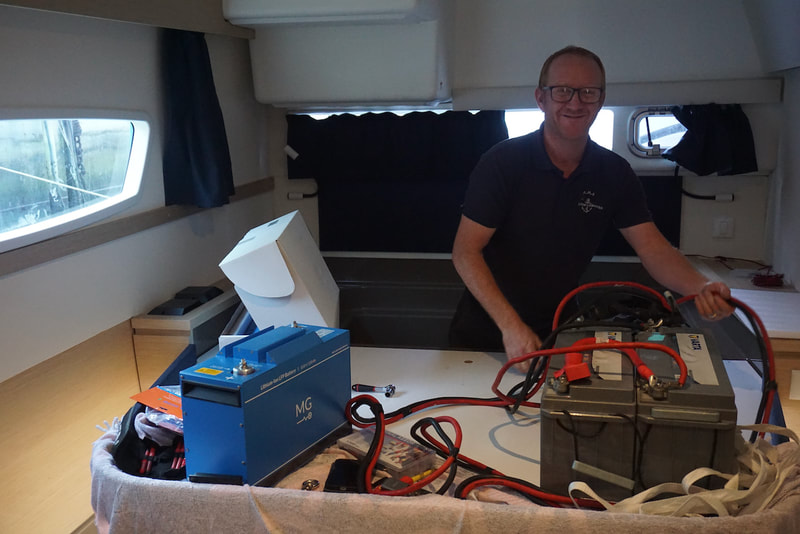
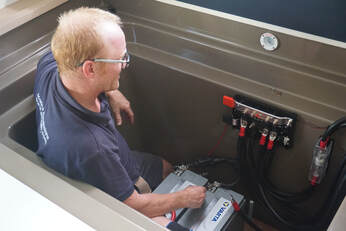
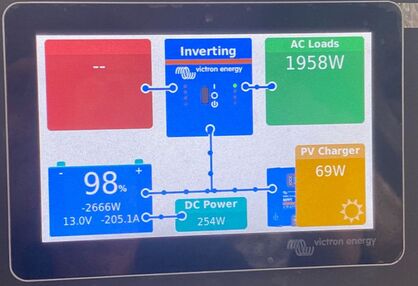
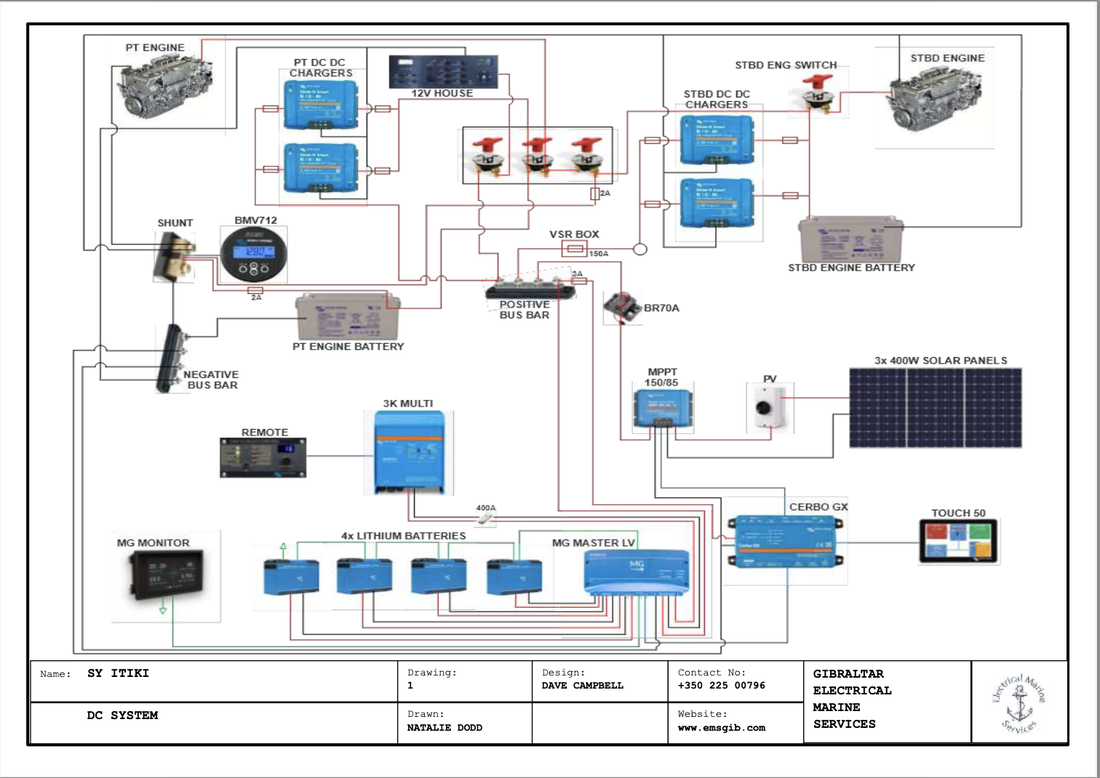
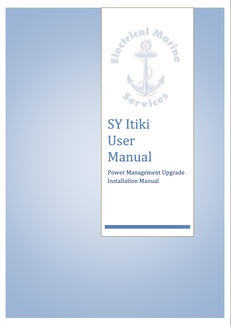
 RSS Feed
RSS Feed
